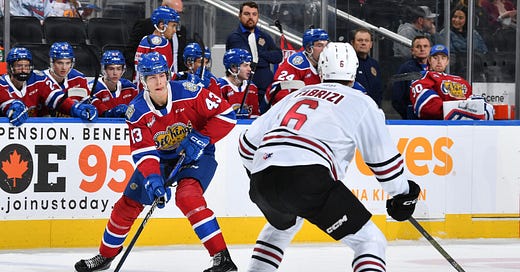St. Louis Blues fans have reason to keep a close eye on Adam Jecho, the towering 6-foot-5 center currently lighting up the Western Hockey League (WHL) with the Edmonton Oil Kings. The 18-year-old Czech prospect, selected 95th overall in the third round of the 2024 NHL Entry Draft, has officially matched his 2023-24 season totals of 23 goals and 47 points—and he’s done so in nine fewer games.
Even more impressive, Jecho’s recent tear has seen him rack up 10 goals and 15 points over his last 10 games, including a scorching five-game stretch where he’s notched seven goals and four assists for 11 points. This offensive surge isn’t just a hot streak—it’s a sign of a prospect rounding into form and hinting at the kind of impact he could have down the line.
A Breakout Sophomore Season in the WHL
Jecho’s rookie campaign with the Oil Kings in 2023-24 was promising, as he posted 23 goals and 24 assists in 54 games—a respectable 0.87 points-per-game clip for a first-year player adjusting to North American hockey after stints in Finland with Tappara’s U18 squad.
Scouts praised his size, powerful shot, and ability to protect the puck, though questions lingered about his consistency, skating, and playmaking upside. Fast forward to the 2024-25 season, and Jecho is answering those questions emphatically. Matching last year’s totals in just 45 games, he’s elevated his game, showing a newfound confidence in his scoring touch and an ability to dominate offensively.
His recent stat line—10 goals and 15 points in 10 games, including seven goals in his last five—highlights a player hitting his stride. Jecho is doing well using his size to crash the net and his quick release to beat goaltenders from distance.
What’s Driving Jecho’s Success?
So, what’s fueling this offensive outburst? From a scouting perspective, Jecho’s physical tools have always been his calling card. At 6-foot-5 and over 200 pounds, he’s a rare blend of size and skill—a forward who can shield the puck with his long reach, power through defenders, and unleash a shot that’s both hard and precise.
His skating, once considered a work in progress for a player of his stature, has shown noticeable improvement this season. He’s not an elite burner, but his long strides and enhanced agility allow him to cover ice effectively, especially in straight-line situations where he can build momentum.
What’s particularly encouraging is how Jecho is leveraging his frame in the offensive zone. Analysts have praised his remarkable ability to position himself in front of the net, where his imposing size poses a significant challenge for both defenders and goaltenders.
His seven goals over the past five games include a mix of net-front tip-ins, wraparounds, and blasts from the slot—evidence of a player expanding his scoring toolkit. His four assists in that span also suggest he’s starting to see the ice better, setting up teammates with smart passes rather than solely relying on his own shot.
That said, Jecho isn’t a finished product. His playmaking remains a secondary strength compared to his goal-scoring instincts, and his defensive game still needs refinement. He’s not a liability by any means as his reach and positioning make him a decent penalty killer, but he’s not yet the two-way force some hoped he’d become when the Blues drafted him.
This isn’t to say he can’t become that type of player in the long run. Jecho still has time on his side.
Projection: Where Could Jecho Be in 2-3 Seasons?
Looking ahead, Blues fans should temper expectations with but with optimism.
Jecho’s trajectory over the next 2-3 seasons will depend on how he builds on this breakout sophomore year. Assuming he finishes the 2024-25 WHL season strong and potentially push past 30 goals and 60 points, he’ll likely earn a long look at earning his Entry-Level Contract.
However, like most 18-year-old prospects, he’s not NHL-ready just yet. With a crowded forward core in the AHL, it’s likely he still returns to the WHL next season to continue to build among his peers. However, an early look and placement with the Springfield Thunderbirds, in 2025-26 does not feel out of place. There, he can refine his skating, boost his physicality, and adapt to the pro game’s pace against tougher competition.
By the 2026-27 season, Jecho should be a consistent AHLer and could even be knocking on the NHL door as a 20-year-old. His ceiling remains a subject of debate among scouts. Optimists see a potential middle-six power forward—a third-line center or winger who can score 15-20 goals, chip in on the power play, and use his size to wear down opponents. His shot and net-front presence draw comparisons to a player like James van Riemsdyk in his prime, though Jecho’s skating and dynamism aren’t quite at that level yet.
If he maxes out his offensive potential and adds a stronger two-way element, a complimentary top-six role similar to Jake Neighbours or David Backes isn’t out of the question. However, that’s a best-case scenario requiring significant growth in his playmaking and defensive IQ.
More conservatively, Jecho projects as a reliable bottom-six forward—a checking-line presence with a scoring touch, capable of 10-15 goals and 25-30 points in a full NHL season. His size and hockey sense should translate to the pros, even if his speed and creativity don’t reach elite levels.
For a Blues team that’s blending veterans with a promising young core—including Dalibor Dvorsky, Jimmy Snuggerud, and Zachary Bolduc—Jecho adds another big, skilled piece to the puzzle.




